In December 2020, a friend reached out to me wanting to make a connection with a co-founder of a new health startup, Levels Health, which provides continuous glucose monitors, along with an app that facilitates insights and learning, direct to consumers. It was great timing, as I had just heard another member of the Levels team on a podcast (this one) and was already intrigued, so I took her up on the offer. Levels offered to send me a month of the product for free, without expectation of sharing anything, and I accepted, assuming I would learn a bit about what foods spike blood sugar, wear it for a month, and move on.
I’m now almost 10 weeks in (having purchased the future months on my own), and I don’t plan to stop anytime soon. I’ve learned SO much and continue learning from it every single day. Whether you want to wear a continuous glucose monitor (CGM) or not, I hope this post is helpful – I provide insights into why blood sugar is important, what I knew about blood sugar management that was confirmed, and things that surprised me about monitoring my blood sugar, like what foods spike blood sugar that I wasn’t expecting. I also have a special offer for you to skip the line (of 60,000 people!) to get a Levels monitor of your own if you’d like at the end of the post.
By the way, if you’re looking for support and guidance in your journey to optimize your health, The Revitalize Health Accelerator might be the perfect fit for you! We talk about blood sugar in far more detail than I can get into in this post. Head here for more information!

A caveat about diabetes: Before I dive into this, let me recognize that this can be a sensitive subject. In fact, when I first shared a video of me applying my CGM on Instagram stories, my own father took offense and (very kindly and considerately) told me why he disagreed with me doing this. Our family is very sensitive to anything related to diabetes, as both my sister and her husband are living with Type 1 diabetes, and will be insulin dependent until there is a cure. They need their CGMs to facilitate managing their condition; rely on insulin to help their body function and stay alive; they deal with so much incredible stress and strain in their daily lives because of this terrible disease. And me wearing a CGM when I am not dependent upon it can bristle people’s feathers. I understand that. Type 1 diabetes will always (until there’s a cure!) be the #1 cause that Kevin and I donate to, and we care about it deeply. Separately, I care about my own health a lot, and want to do anything possible to improve it. This article, from another individual living with Type 1 diabetes, says it better than I could ever, but the essence is this: even in non-diabetics, insulin resistance and blood sugar management is a huge health issue, and anything that can help that is a wonderful thing. And hopefully, as we expand consumer demand for CGMs, we can encourage companies to increase supply, eventually lower cost, and make CGMs more widely available and accessible to diabetics (and non-diabetics) worldwide.
Why monitoring blood sugar is important
So, for someone without diabetes, why is managing blood sugar important? And what is blood sugar, anyway? At a very basic level, when we eat any sugar, or anything that breaks down into sugar (including any carbohydrates, whether from zucchini or candy corn), that sugar is released into the bloodstream. In people with functioning pancreases (anyone without Type 1 diabetes), insulin is released in response to sugar in the bloodstream. The role of insulin is to grab the sugar from the bloodstream and shuttle it into our cells, where it can be used as energy to power our daily activities.
But many things (like a diet high in refined sugars and processed food, imbalanced gut health, chronic stress, mineral deficiencies, and so much more) can make us insulin resistant, which means that even as we get an appropriate amount of insulin release, it just doesn’t work as well, so more sugar (glucose) hangs out in the bloodstream for longer. This happens regularly – in fact, it’s likely that only 12% of the American population is completely metabolically healthy.

Too much sugar in the bloodstream once or twice is no big deal, but over time, lack of metabolic health can lead to Type 2 diabetes (84% of people with prediabetes don’t know it, and 70% of those will become diabetic within 10 years), which leads to a ton of other issues (in fact, healthcare costs resulting from diabetes are expected to exceed $300 billion by 2030).
Managing blood sugar can also help manage weight, because excess insulin (which is required when blood sugar is too high) has a side effect of telling our bodies to store fat, which most of us aren’t looking for. So, in general, more stable blood sugar means it’s easier to maintain your weight and body composition!
There are tons of intricacies, but in general, two factors are important for maintaining your metabolic health: the height of the blood sugar spike, and the area under the curve. The height of the blood sugar spike means how high blood sugar gets at its highest (as you’ll see from the white line in the first graph, white rice caused a blood sugar spike of +41 in this image taken from the Levels Instagram). In a spike, the blood sugar usually decreases relatively quickly. The area under the curve, on the other hand, is the total elevation, taking into account both time of elevation and increase in blood sugar. As you’ll see in the white line in the second graph, regular pasta caused this person a large area under the curve because it stays elevated for a long time (also taken from Levels Instagram). In general, we want to maintain a lower blood sugar, so the large area under the curve seems “worse,” but dramatic spikes are not great for metabolic health either. We’re really going for foods that barely elevate blood sugar at all, and when they do, facilitate gently returning to a normal level quickly.
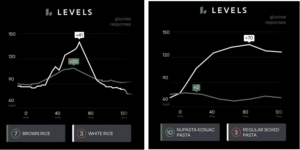
How to balance blood sugar
While I was wearing my CGM, many things I already know (and teach to clients) were confirmed. Here are a few of these tips to manage your blood sugar:
- The more sugary the food, the higher the blood sugar spike. This just makes sense. More sugar in food = more sugar in blood = body has to work harder to secrete the right amount of insulin and cells have to be insulin sensitive enough to uptake all that sugar.
- The more fibrous the food, the lower the blood sugar spike. Even though both fiber and sugar are carbohydrates, eating fiber is far less likely to spike your blood sugar than eating sugar.
- Fat is a powerful tool at slowing and reducing blood sugar spikes. Fat takes longer to pass through the digestive tract and slows food absorption, meaning that it helps sugar release slowly instead of rushing into the bloodstream. This is a good thing.
- Carbohydrates that are not balanced by protein or fat (what I called “naked carbohydrates”) lead to more dramatic blood sugar spikes. If you’ve been a client of mine, you’ll know that I always recommend macronutrient balance – choosing meals with a source of protein, a source of healthy fat, and a source of carbohydrates (ideally, mostly non-starchy vegetables). This is because, when balanced by protein and fat, our body is much better able to process carbohydrates, leading to a less dramatic blood sugar spike.
- Refined carbohydrates are particularly detrimental, but there are almost always alternatives. This image (from Levels Instagram) shows a giant spike from pancakes with maple syrup (all carbohydrates), vs. a small hump from almond flour pancakes with nut butter, which are more fat-based. I love the poster’s comment that seeing the data empowered him to make change!
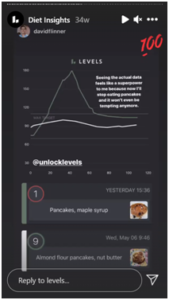
- Exercise can either raise or lower blood sugar. In general, low-intensity exercise like a walk can reduce blood sugar, because your body is using energy immediately and muscle cells are primed to uptake the sugar. However, high intensity exercise can often have the opposite effect – if there isn’t enough sugar in the bloodstream, our liver releases glycogen, a storage form of glucose, in order to fuel our activity. The blood sugar spikes from exercise are less detrimental, and Levels is working on algorithm changes to not have exercise spikes detract from our overall health ratings. Below, you’ll see two images from my own data. The first shows a walk as soon as my blood sugar was rising. The walk helped return my blood sugar to a fasting level, which is good. The second shows a “normal” workout for me on a weekday morning … not what I would call high intensity, but not as easy as a walk. In this case, I did a 3-mile run, then 45 minute back and chest strength training. You’ll notice a small peak, but not a spike, as my liver released just enough glycogen to get me going, but not so much as to indicate that it was under stress.
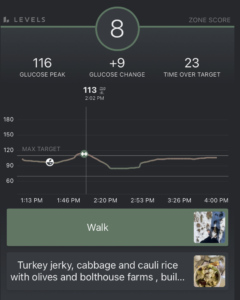
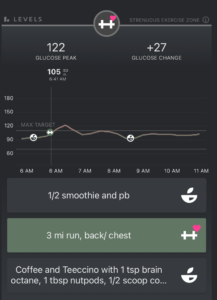
What surprised me about my blood sugar
I’ll be honest – with a Masters in Holistic Nutrition and a bunch of other certifications, I didn’t expect to be that surprised by my blood sugar. But I learned a ton and am continuing to learn! Here are a few serious, and a few fun, lessons that stood out to me:
- Stress. Stress stress stress. WOW – I was blown away by how much it impacted my blood sugar! I have a long history with stress management (a little glimpse into it is available here), so I suspected that my blood sugar responses might not be “normal” because of my ongoing efforts to manage my chronically high cortisol. But I had NO idea it would impact my blood sugar this much! In the below example, I woke up to find half the pipes in our house frozen in the recent Texas storm, absolutely panicked because I was the one to tell Kevin not to drip the faucets, and spiraled myself into anxiety of our whole house being flooded. I only had coffee (balanced with protein in the form of collagen and healthy fat in the form of brain octane oil), which doesn’t spike my blood sugar when balanced that way, but the stress skyrocketed me to the highest number I’ve ever seen, 172! It was brought down by exercise, meditation, and Kevin telling me it would all be fine, but wow, this surprised me! While other peaks were less dramatic, the effect of stress was replicated in my personal data many times.
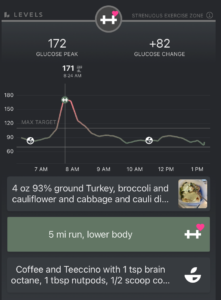
- Meals vs. snacks. While I prefer smaller meals and multiple snacks, my body actually did better on larger meals. I hated to see this data, but it was unavoidable. Eating large meals, like this turkey burger with a smear of avocado on a Smart Bun with tons of roasted vegetables and my favorite cauliflower dip, scored me a 10 (Levels gives each meal a 1-10 rating based on its algorithm, which is an amazing feature that helps us make sense of the data!). I did less well with small snacks throughout the day.
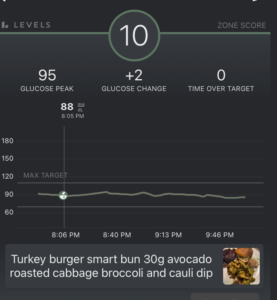
- My body loves chocolate as much as I do. This was the BEST. NEWS. EVER, as I love chocolate enough to keep it in my Instagram bio, so it HAD to be a pass. When I chose low- to no-sugar added chocolate (see Megan Recommends for some of my favorites!), I experienced almost no spike, thanks to the higher fat content and lower sugar content of chocolate. This picture from the Levels Instagram shows the impact of Lily’s stevia sweetened chocolate vs. candy conversation hearts (pure sugar).
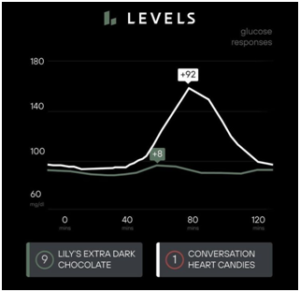
- Sometimes, processed, low-sugar products did better than actual food. This is where it gets precarious from a nutritionist’s perspective. I had to remind myself regularly that blood sugar isn’t everything. If it were, I’d be eating packaged, chemicalized junk food all day, rather than a breakfast hash that happened to contain a bit of sweet potato, because it scored better. I know better, and I want to make sure you know better too. Blood sugar is important, but the quality of food is still critical. So, when I tried this Quest bar (which I generally don’t recommend due to the factory-made ingredients), I was surprised to see that it scored a 10 from Levels!
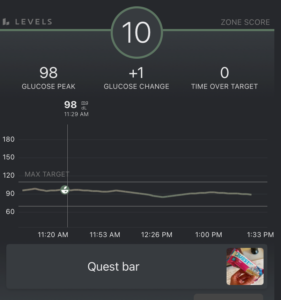
- Smoothies did really well. While I always follow my Magic Smoothie Formula to help me balance out macronutrients appropriately, I suspected that a smoothie might still raise blood sugar due to the fruit content. Surprisingly, it didn’t, and I did great with smoothies!
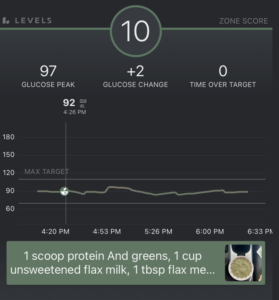
- The order of foods consumed really mattered. I teach this, yet seeing it in real data was pretty cool to see! Let me let you in on a little secret: sometimes, I eat Rice Chex, which certainly are NOT the epitome of health food, on my nightly protein milkshake. I guarantee that if I ate Rice Chex on an empty stomach, it would cause a giant spike. But after this meal, of tuna tacos on jicama tortillas with lots of veggies and a protein shake after, the Rice Chex added in had little to no impact! Eating carbohydrates last really helps.
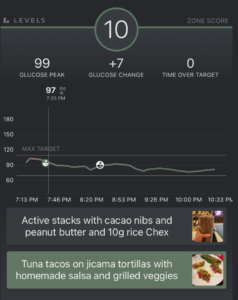
- Alcohol wasn’t detrimental (and in some cases, helped). Of course, this doesn’t mean alcohol is a health food. But alcohol never spiked my blood sugar, and in many cases, lowered it (likely due to stress reduction). In this case, I had two Truly drinks with some veggies and dip, followed by dinner, all within range.
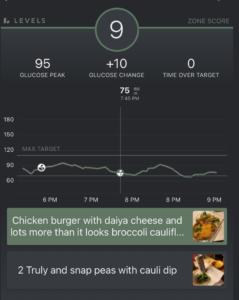
- Some foods have abnormal spikes. When we talk about blood sugar in the nutrition world, grapes often come up as one of the most dramatic offenders. I decided to test this, by having a balanced meal of 1 egg, 2 egg whites, 1.5 cups of veggies, and avocado, plus a slice of bacon. This is very balanced and would not spike my blood sugar usually. I had 15 grapes at the end of the meal (the appropriate time to have carbohydrates) and saw one of the biggest spikes I have ever seen! My body handles berries, pears, citrus, cherries, and apples fairly well, but not grapes. I never would have known this without wearing a CGM! Similarly, on Christmas Eve, my husband’s family’s tradition is to order Chinese food. Feeling festive, I decided to add ½ cup white rice to my steamed veggies and shrimp, and saw a +64 … a giant spike confirming my decision to very rarely eat grains. This does not mean grains aren’t healthy for you – in fact, the Levels Instagram shows several people whose body handles grains very well – but it confirms what I have always known: that grains don’t work great for me.
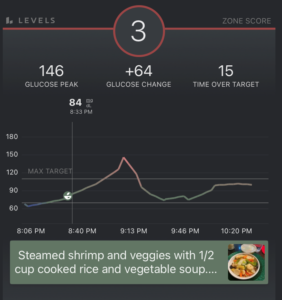

Why I like Levels, and how you can skip the waiting list for a CGM
I have tried a CGM before with another startup, and I was not a big fan of their data analytics. It was very confusing from a user experience perspective and left me more frustrated than it was worth. Levels is exactly the opposite – very easy to understand, excellent customer service, and easily extractable insights that helped me make changes that work for me personally.
I highly recommend Levels to all of you, and have already recommended the service to many of my clients. The not great news is that it’s pricey: the first month (including the physician approval to get you a CGM) is $399; after that, it runs $199 / month. The great news is that Levels has a 60,000-person waiting list … but you can skip the list with my link! If you want to experiment with a CGM, register for Levels here.
And if you find yourself needing help in making adjustments, my one-time consultation might be a fit for you! Or, if you want more continuous support to make true lifestyle change, my Revitalize Health Accelerator might be a fit for you!
Now it’s your turn … What surprises you about blood sugar stability or what foods spike blood sugar? Would you wear a CGM?

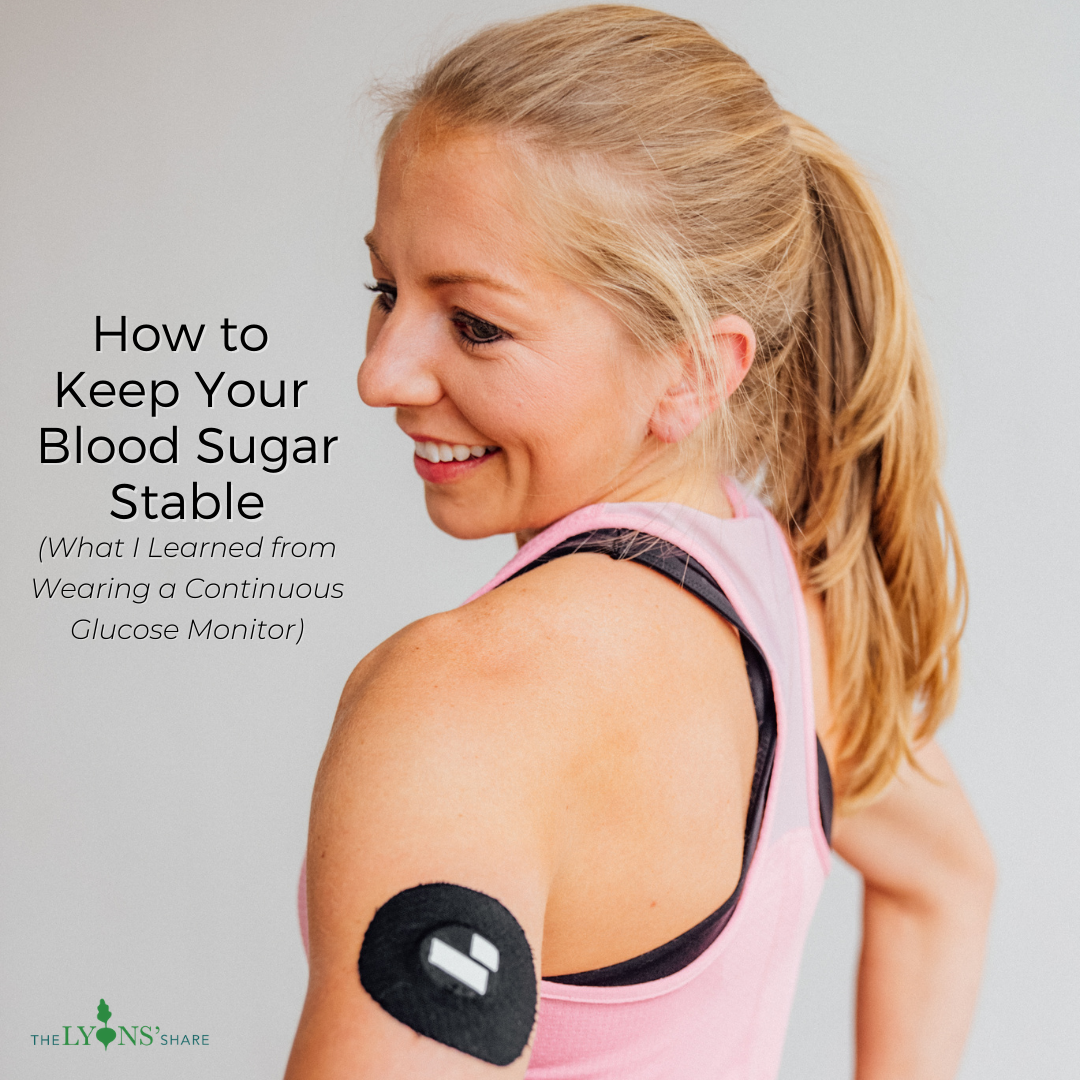
I would wear this, but you are right – not cheap. I’m wondering is this is covered by insurance versus the others that apparently are?
Hello! If your doctor declares that you need a CGM for diabetes management, it would be covered by insurance under most plans. The Levels program is for people without diabetes who are looking to optimize their health, and unfortunately (while I hope this changes soon!) most insurance companies are less focused on preventative health and more on existing issues. I hope that with increased demand we can change this and make it more accessible!
I wore a CGM for 2 weeks. I was surprised that my Blood sugar was low or in range 70’s -80 very few spikes, though my A1C is 5.7 any suggestions or reasons you can give? Thanks
Hi Barbara. I can’t offer personal advice without working with you one-to-one, but there are several things that could be causing this! Maybe investigate whether you think you ate differently due to wearing your CGM (which is normal) to start out. Best of luck!
Great article and great info, Megan!
Thank you for reading, Kellie!
Thank you, Sam!
This is a really great article 🙂